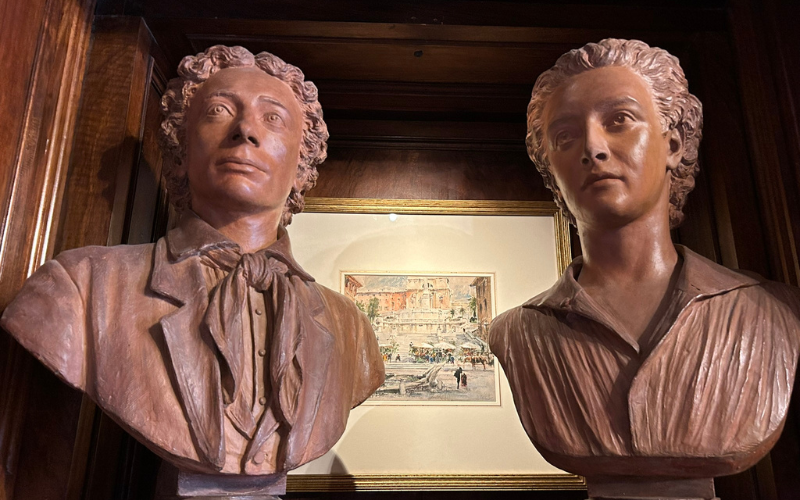Visit Rome’s Best Kept Literary Oasis: The Keats-Shelley House
This post may contain affiliate links to products or services I'm happy to recommend. If you click on an affiliate link and then make a purchase, Artsy Traveler may earn a small commission at no cost to you. Thank you!
The Keats-Shelley House is nestled right next to the world famous Spanish Steps in Rome. Thousands of visitors mill around the piazza in front of the steps, climb the steps, and take pictures of the steps.
Yes, the steps really are very attractive–lots of flowers and a striking two-tower church at the top.
But in the end, the steps are, well, steps. If you go to the Spanish Steps, take a quick pic and then veer right to visit the lovely little Keats-Shelley House. You’re in for a first-rate Artsy Traveler experience.
Literary Leanings
If you’ve been reading the Artsy Traveler blog for awhile, you probably know that I write mostly arts-inspired historical novels. My first three novels feature a painter (The Towers of Tuscany), a composer (A Woman of Note), and an actress (The Muse of Fire). So, as a novelist, I’m a lover of literature, and what could be more literary than two of the greatest Romantic poets?
Also, back in the day when I went to university in England, I took my degree in English Literature. As a result, I studied a lot of poetry, particularly by Shelley. So to enter rooms where Keats and Shelley hung out, really is a pilgrimage.
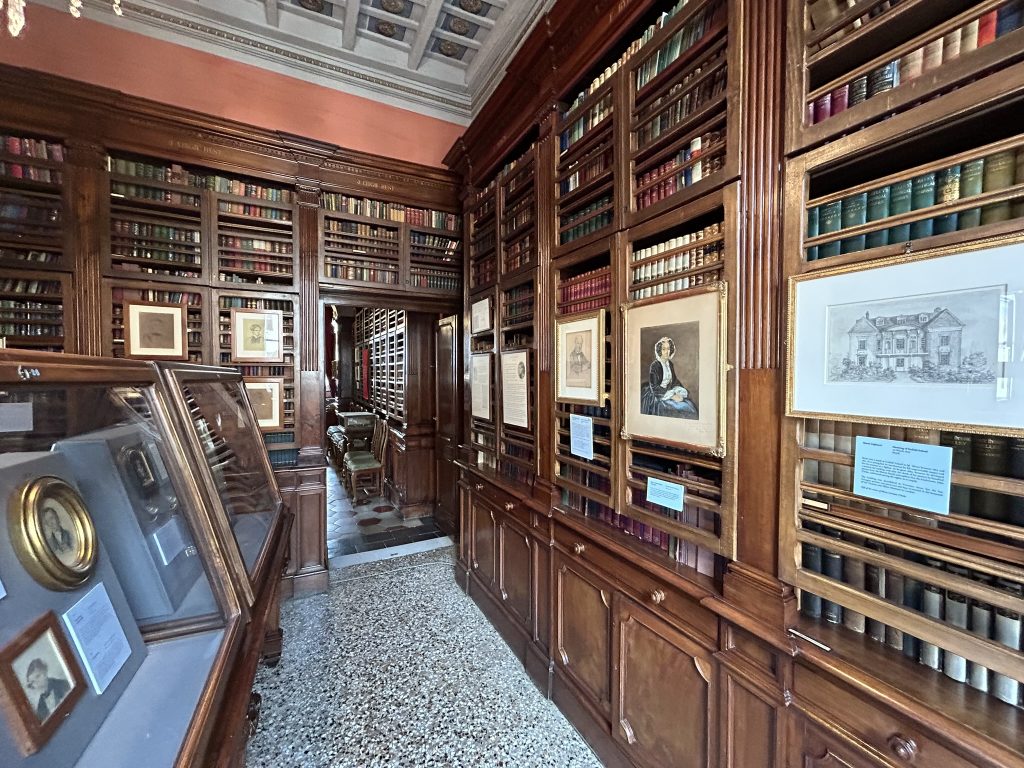
Touring the Keats-Shelley House
The Keats-Shelley House is extremely easy to find thanks to its location next to the Spanish Steps. You’ll also see the banner hanging outside. The Keats-Shelley House is open from 10 to 1 and 2 to 6, and includes a special rate for seniors.
The ticket person got on my good side by telling us we didn’t qualify for the senior’s rate because it’s only for people over 65. Awww. That was kind of her. But needless to say, I corrected her and got the reduced rate.
You enter the museum and climb to the first floor where you’ll find the tiny gift shop (more on that later) and the ticket taker. After paying the entrance fee, turn right to tour a series of beautiful rooms containing a great many treasures and curiosities associated with the lives and works of several of the Romantic poets and their associates.
You’ll see letters written by Keats, Shelley, Bryon, Mary Shelley, Wordsworth, and other luminaries from the time. The evenness of their penmanship puts most modern folks to shame! Also on display are drawings, snippets of poetry, paintings, and other memorabilia. The explanations are clear and informative.
Why The Poets Loved Italy
Back in the 18th and 19th centuries, with a decade or two off during the beginning of the 19th century for the Napoleonic Wars, Italy was a mecca for poets and writers from northern climes, including the Romantic poets from England, and Goethe from Germany. These writers loved Italy’s warm weather, easy-going life, and the inspiration to be found in so many centuries of history. What attracted them to Italy back then isn’t so very different from what attracts me to Italy today.
It’s a very special country with so much to offer. No wonder I keep coming back year after year!
Rooms in the Keats-Shelley House
The rooms in the Keats-Shelley House include a library of more than 8,000 volumes. It’s considered one of the finest libraries of Romantic literature in the world. Thoughtfully presented displays provide you with a lot to read as you prowl around the rooms. You could spend a great deal of time here!
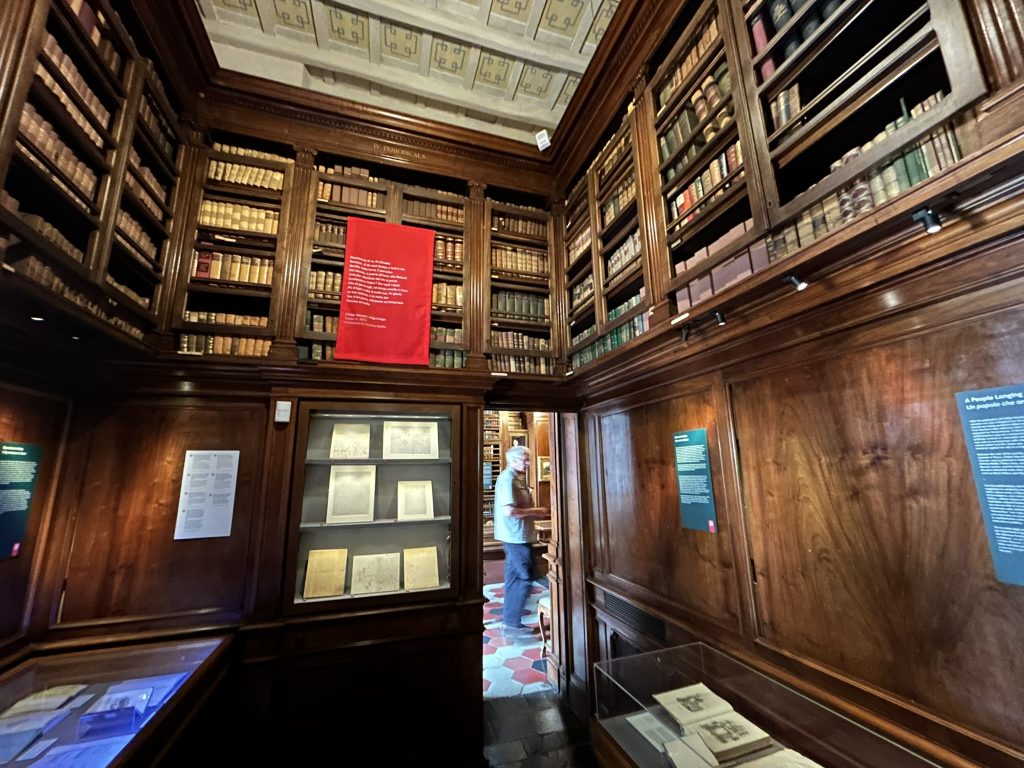
The tour through the rooms ends at the tiny bedroom where John Keats died on February 23, 1821 at the age of just 25. It’s astonishing how he was able to compose so much sublime poetry in so few years. The museum includes plenty of information in English and Italian about Keats, his life, his tragic death, and of course his poetry.
Was it a vision, or a waking dream?
Fled is that music:—Do I wake or sleep?
From Ode to a Nightingale
Here is the bed on which Keats died.
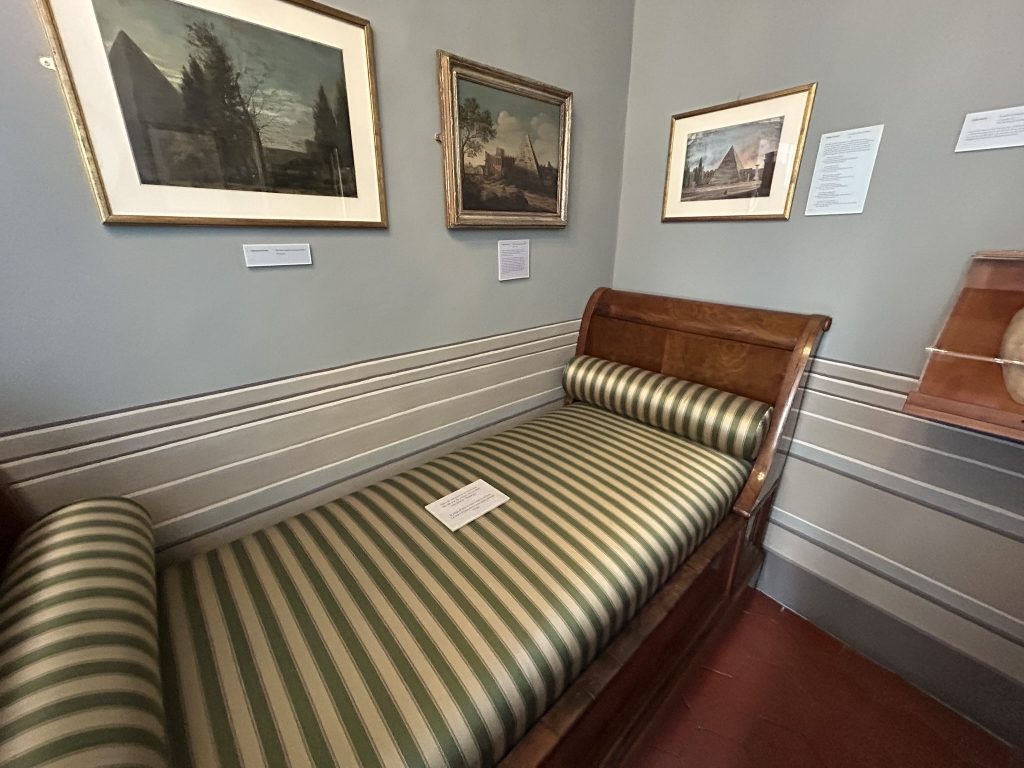
Byron’s Bicentenary
At first, I was mystified by the several banners related to Byron on display in the main library. After all, it’s the Keats-Shelley House. The very friendly and knowledgeable attendant told us that the House is celebrating the Bicentenary of Byron’s death in 1824.
His poetry is figured prominently on red banners. I haven’t read Byron for many years, so it was a real treat to reacquaint myself with some of his poetry.
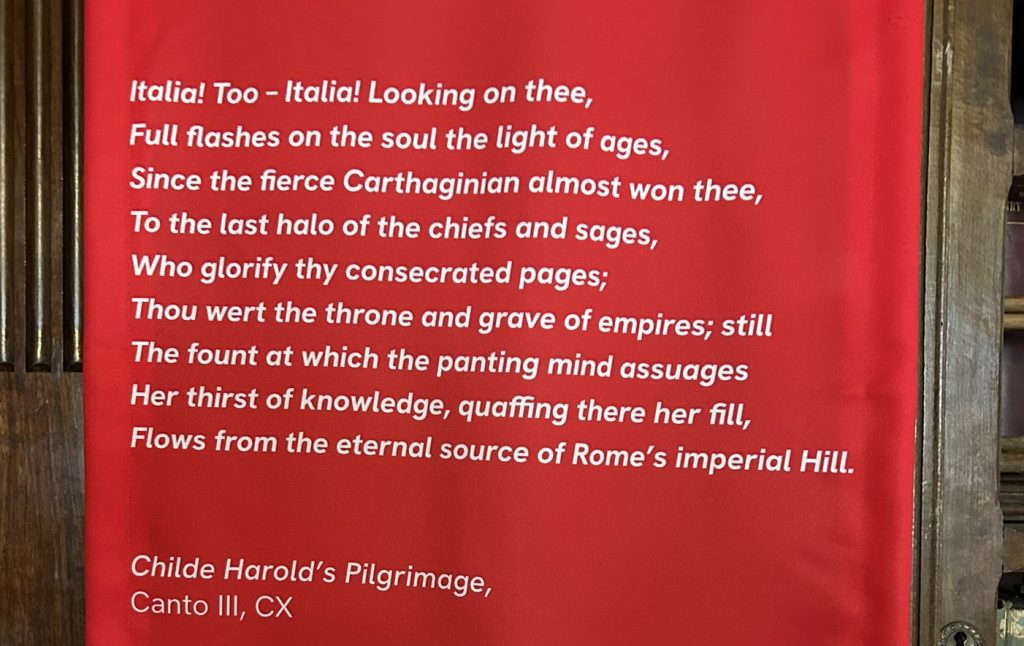
We had a great chat with the attendant about the poets, Mary Shelley and her mum Mary Wollstonecraft, and the arts in general. I mentioned that I’d interviewed Samantha Silva, author of Love and Fury about Mary Wollstonecraft on The Art In Fiction Podcast. Since the attendant was obviously interested in the era, I figured she may want to read the novel (highly recommended, by the way). She was delighted to learn about it and promised to look up the podcast.
I also told her about my novels and gave her one of my bookmarks because, well, marketing.
The Terrace
A highlight of a visit to the Keats-Shelley House is walking out on to the sweet little terrace overlooking the Spanish Steps. Imagine Keats and the gang sitting out there on a warm May afternoon sipping tea and talking poetry! It’s pretty cool to think that the view Keats saw wasn’t all that dissimilar to the view we see today.
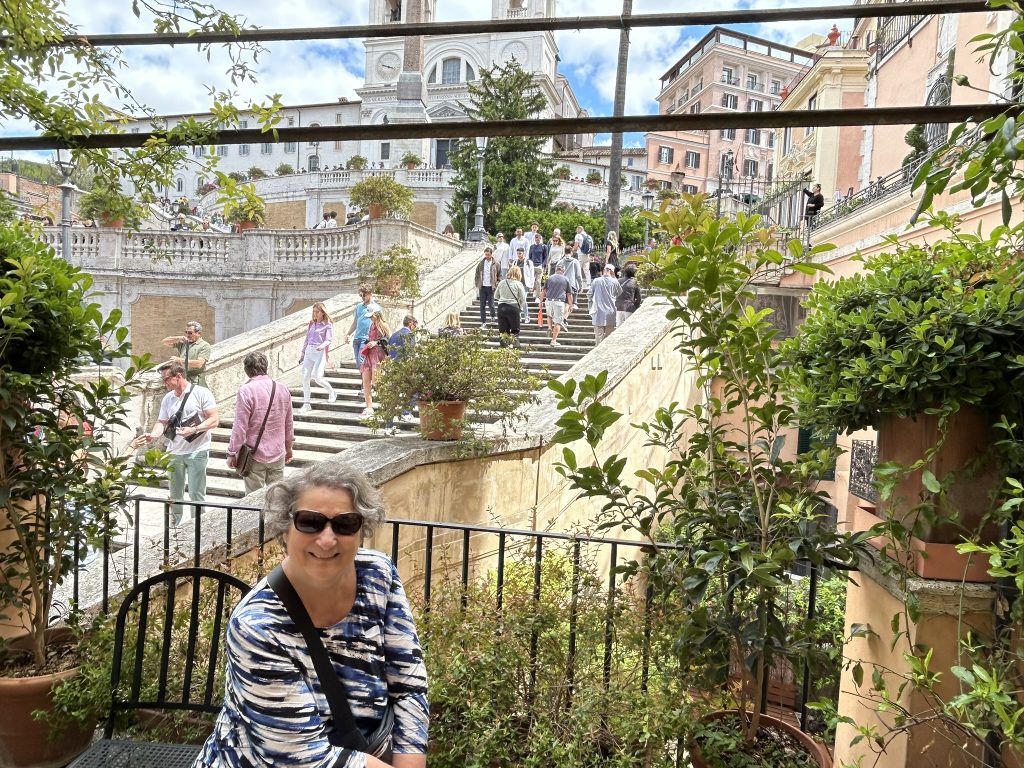
The house included drawings of the Piazza Spagna and the steps in the early 19th century, and indeed, not much has changed if you look above the ground floor shops.
The Gift Shop
After thoroughly enjoying touring the rooms, we exited via the gift shop. I couldn’t resist buying myself a cloth bag with a Grecian Urn on it, homage to Keats’s Ode to a Grecian Urn. I also studied the collection of fridge magnets. We’ve taken to buying them most places we visit. Back home, our fridge door is getting pretty full up, but there’s always room for one more, or in this case, three.
I couldn’t decide which magnet to buy–Keats, Shelley, or Bryon–and so I bought all three. Here they are–Keats on the left, Shelley in the middle, and Byron on the right. These guys were all in the twenties and early thirties when they were hanging out together, and all three died young. They’re a bit like the rock stars of their time–living with unbridled passion and energy that burned out quickly, but wow, what a legacy they each left in their wake!
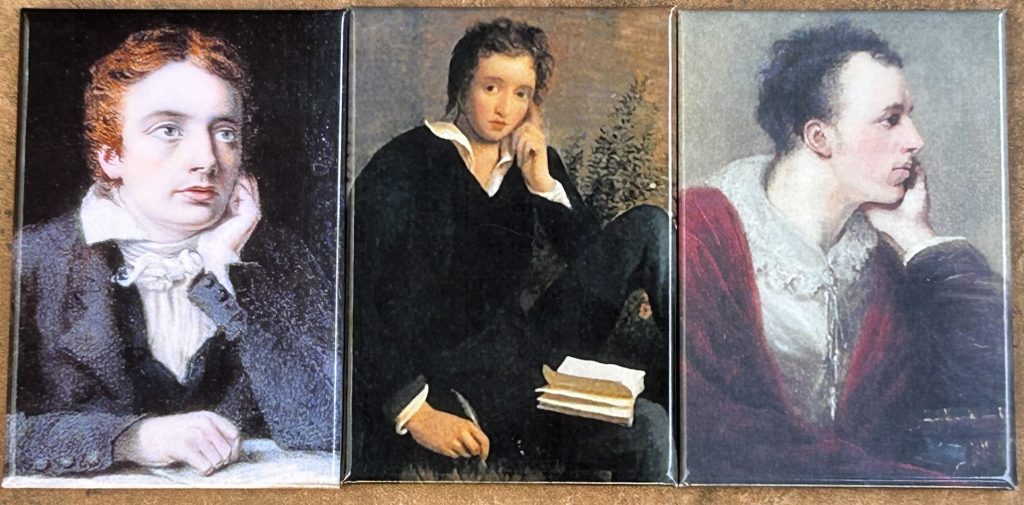
Conclusion
Have you visited the Keats-Shelley House in Rome? What did you think Share your impressions in the comments below for other Artsy Travelers.
Artsy Tours in Rome
I couldn’t find any literary-themed tours in Rome on Get Your Guide, so here’s a selection of tours related to music and also a tour of locations mentioned in Dan Brown’s Da Vinci Code series. Note that I include tours listed on the Get Your Guide website because I’ve taken and enjoyed many of their tours. Also, full disclosure, if you click on any tour below to go to the Get Your Guide website and purchase a tour (any tour), I get a small commission. Thank you!
Other Literary Leaning Posts on Artsy Traveler
- Compelling Novels Set in Italy Perfect for the Artsy Traveler
- Stratford-upon-Avon: A Must-Stop for the Artsy Traveler
- Love Among the Recipes: Paris Sights & Bistro Dishes
